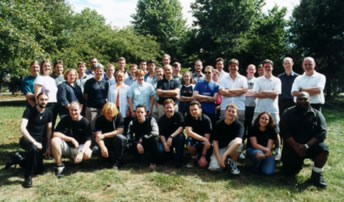Company History (1985 - 2008)
Part 2 - The 'New' Micro Forté & Growth of the Australian Industry
The new Micro Forté started work on smaller children’s game projects such as Nordice and Bombs Away. This time, John, Steve and Simon developed a business plan that involved John’s vision of a future where Micro Forté would become an independent developer of massively multiplayer online role playing games.

Fallout Tactics team Canberra 2001
After the development of Enemy Infestation (Ripcord), and during the development of Fallout Tactics: Brotherhood of Steel for Interplay (US) and HotWheels Bash Arena for THQ, the company embarked upon John’s visionary project of developing what would arguably be the world’s first massively multiplayer middleware solution.
John’s vision was largely based on having played two-player games against Stephen Lewis over a 300 baud modem, such as CommandHQ. The explosion of Bulletin Board Services (BBS) and the advent of the internet gave John the insight that massively multiplayer games were to become a significant new form of entertainment. This was an amazing call in 1996, given that, the dot.com boom was yet to occur and Ultima Online had not yet launched.
John’s original idea was called “GameNet”, a single page outline of the original BigWorld dream. John and Stephen Lewis created a method and ultimately a patent for a communication system and method for massively multiplayer games and lodged that patent in October 1996. As part of the business plan, Micro Forté sought and won venture capital funding from Allen & Buckeridge as well as a substantial Research and Development grant from the Australian Government. This project was codenamed “Large Scale Multiplayer Persistent Universe” as the term MMO had not become the accepted acronym it is today, and was later changed by Micro Forté to MMOG, a massively multiplayer online game. Simon reworked that original design, and alongside Steve Wang as Head of Studios, started on the long journey towards the BigWorld Technology Suite. Many ‘would-be’ competitors that started later failed to catch up, or simply gave up along the way.
Part of the business plan required Micro Forté to have ongoing access to young talented games developers, but in Australia during the mid 90’s these people were all-but-impossible to find. John had come to the idea of creating a non-profit educational institution that would meet the demands of Micro Forté’s growth, as well as the growth of the only two other local game developers (SSG and Beam), training developers in specific areas such as 3D Animation, Level design, Programming and QA.

AIE Canberra Campus Sept 2001 - 17,000 M2 of space !
In 1996, after forming a partnership with the Canberra Institute of Technology, attaining a small government grant, and undertaking many years of hard work, the Academy of Interactive Entertainment Ltd (AIE) www.aie.edu.au was born. AIE and Micro Forté were based at the newly created Canberra Technology Park www.canberratechpark.com, which John founded to create synergy amongst IT related businesses. Without going into too much detail, the birth of the AIE ushered in a new era for the entire Australian computer games industry. No one foresaw then, including John, the enormous influence this institution would have for Australia. John would later be given the title of “Honorary Ambassador” by the Australian Capital Territory government for his efforts. The AIE has since trained thousands of 3D animators, 3D modellers, texture artists and game programmers. From its humble beginnings with three lonely game companies, the Australian game development industry has undergone explosive growth. There are currently 40 companies, which have produced over 200 titles to date.
As the industry grew, John was quick to realize that an industry conference was needed. John had been involved in the early days of the American Computer Game Developers Conference in Santa Clara and through his contacts with the founders of the CGDC, he set about creating Australia’s equivalent – the Australian Game Developers Conference (AGDC) www.agdc.com.au.
The AGDC went on to become the prime industry conference, with over one thousand delegates annually. AGDC enabled the industry to get together, share development approaches, and attract new talent into companies such as Micro Forté and eventually BigWorld. AGDC was renowned for its developer parties, international speakers, information sharing, and general goodwill amongst the industry leaders.
John also founded and launched the Game Developers Association of Australia (GDAA) www.gdaa.com.au during the first AGDC, providing the initial funds, its constitution and resources to get the association started, as well as persuading key local development companies to join and take their rightful place on the association’s board. John was himself unwilling to lead this organization as its President, deciding to focus on game development projects within Micro Forté, and on the emerging BigWorld Technology platform that would eventually become arguably the industry standard and middleware of choice for aspiring Virtual Worlds and MMO game development companies.
Go to Part 3 - Developing BigWorld Technology & Chartering a New Path for Micro Forté Studios >